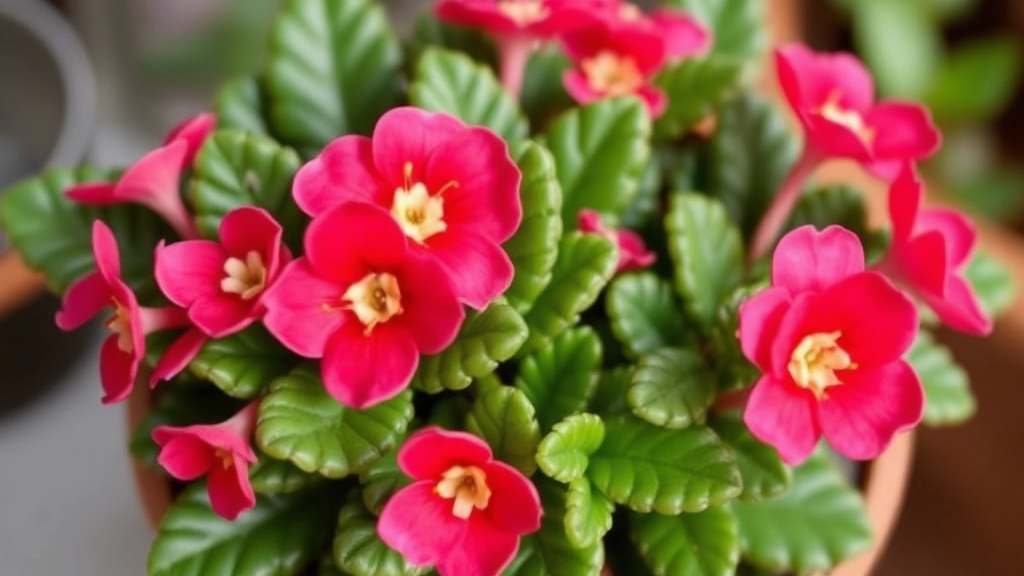Mastering Kalanchoe Maternity Plant Care
If you’re looking to master Kalanchoe Maternity Plant Care, you’re in the right place. The Mother of Thousands, or Kalanchoe daigremontiana, is a unique plant that requires specific care to thrive. From ideal light conditions to proper watering techniques, I’ll guide you through everything you need to know to keep your plant healthy and vibrant.
Light Conditions
First, let’s talk light. This plant loves bright, indirect sunlight. Too much direct sun can scorch its leaves, while too little light can stunt its growth. Pair this with well-draining soil to prevent root rot, and you’ll set a strong foundation for your Kalanchoe.
Next Steps
Ready to dive deeper? Let’s explore watering, propagation, and more to ensure your plant flourishes.
Ideal Light Conditions for Mother of Thousands
Are you struggling to provide the right light for your Mother of Thousands?
Understanding the light requirements of this unique plant is essential for its thriving growth.
Mother of Thousands (Kalanchoe daigremontiana) flourishes in bright, indirect sunlight.
Choosing the Best Soil for Healthy Growth

So, you’ve got your Mother of Thousands and you’re wondering, “What’s the best soil for this little beauty?”
Choosing the right soil is crucial for keeping your plant thriving.
Key Soil Characteristics
- Well-Draining:
- Mother of Thousands love to dry out between waterings.
- Look for soil that allows excess water to escape easily.
- Lightweight:
- A mix that isn’t too dense helps roots breathe.
- Consider using a cactus or succulent mix as a base.
- Nutrient-Rich:
- While they don’t need a lot of nutrients, a little organic matter can help.
- Adding compost or worm castings can boost growth without overwhelming the plant.
Recommended Soil Mix
Here’s a simple recipe you can whip up:
- 50% cactus/succulent mix
- 25% perlite or pumice for drainage
- 25% organic compost for nutrients
Mix it all together and you’re ready to pot!
Store-Bought Options
If DIY isn’t your thing, look for pre-made mixes labelled for cacti or succulents. Just make sure it’s well-draining.
Proper Watering Techniques to Avoid Root Rot
One of the most common concerns for those caring for Mother of Thousands is ensuring the right watering practices to prevent root rot.
Why is Root Rot a Concern?
Root rot occurs when the roots sit in waterlogged soil, leading to decay. This can be a nightmare for your plant, as it can quickly lead to its demise.
Effective Watering Strategies:
To maintain a healthy Mother of Thousands, consider the following tips:
- Check the Soil Moisture: Always check the top inch of soil before watering. If it feels dry, it’s time to water.
- Use Well-Draining Soil: A mix that includes sand or perlite will help excess water escape.
- Water Thoroughly but Sparingly: When you do water, ensure you soak the soil thoroughly, allowing excess water to drain out.
- Avoid Watering Schedule: Instead of sticking to a strict schedule, adjust based on the plant’s needs and environmental conditions.
- Use Pots with Drainage Holes: This is crucial. Ensure your pot has drainage holes to allow excess water to escape.
- Consider the Season: In the growing season (spring and summer), you may need to water more frequently, while in the dormant season (autumn and winter), reduce watering.
By following these techniques, you can significantly reduce the risk of root rot and promote robust growth in your Mother of Thousands.
For more detailed care instructions, you might also want to check out our Leopard Mother of Thousands care guide.
Temperature and Humidity Preferences for Indoors and Outdoors

Are you perplexed about the ideal temperature and humidity for your Mother of Thousands?
Understanding these factors is crucial for fostering a thriving plant.
Temperature Requirements
Mother of Thousands, or Kalanchoe daigremontiana, prefers a warm environment.
- Ideal Temperature Range:
- Daytime: 20°C to 30°C (68°F to 86°F)
- Nighttime: 10°C to 15°C (50°F to 59°F)
This plant is sensitive to extreme cold.
If temperatures dip below 10°C (50°F), it can suffer damage.
Humidity Levels
When it comes to humidity, Mother of Thousands thrives in moderate conditions.
- Optimal Humidity:
- Range: 30% to 50%
Too much humidity can lead to issues like root rot, while too little can cause stress.
Indoor vs. Outdoor Conditions
- Indoors:
- Keep your plant near a window with indirect sunlight.
- Avoid placing it near drafts or heating vents.
- Outdoors:
- Choose a location that offers partial shade, especially during the hottest part of the day.
- Ensure the plant is protected from frost.
Practical Tips
- Check Temperature Regularly: Use a thermometer to monitor conditions.
- Humidity Control: If your home is dry, consider a humidifier or pebble tray with water to increase moisture.
- Seasonal Adjustments: Be mindful of seasonal changes and adjust your plant’s location accordingly.
Best Practices for Propagating Baby Plantlets
When it comes to propagating Mother of Thousands, many plant enthusiasts often wonder about the most effective methods.
Understanding Plantlets
These resilient plants naturally produce tiny offsets, or plantlets, that can easily be propagated.
Here are some best practices to follow:
- Timing is Key: The best time to propagate is during the growing season, typically in spring or early summer. This ensures the plantlets have ample time to establish roots before winter.
- Select Healthy Offsets: Choose the healthiest plantlets that are at least a few inches long. Look for those with vibrant colour and no signs of disease.
- Proper Removal: Gently twist or cut the offsets from the mother plant. Ensure you leave a small piece of stem attached to the plantlet for better rooting.
- Let Them Callous: Place the removed plantlets in a dry, shaded area for a few hours or overnight. This allows the cut end to callous over, reducing the risk of rot when planted.
- Soil Preparation: Use a well-draining soil mix. A combination of cactus mix and perlite works well, ensuring excess moisture can escape.
- Planting: Create small holes in the soil and place the calloused end of the plantlet into the mix. Firm the soil around it for stability.
- Water Sparingly: After planting, lightly mist the soil. Avoid overwatering as this can lead to root rot. Wait a week before watering again.
- Humidity and Light: Provide a humid environment by covering the pot with a plastic bag or placing it in a propagator. Ensure it receives bright, indirect sunlight.
By following these steps, you’ll increase your chances of successfully propagating healthy baby plantlets. For more detailed guidance, you can refer to the Complete Guide to Caring for Kalanchoe Mother of Millions Plant and learn about the Step-by-Step Guide to Grow Kalanchoe from Leaf Cuttings.
Common Issues and How to Prevent Overgrowth

Have you ever looked at your Mother of Thousands and thought, “Why is it getting out of hand?” You’re not alone! These charming little plants can quickly become overwhelming if not kept in check.
Common Issues:
- Overcrowding
These plants love to spread, which can lead to overcrowding.
If left unchecked, they can choke each other out. - Pests
Watch out for mealybugs and aphids. They love to feast on your lovely leaves.
A quick inspection can save you a lot of hassle. - Root Rot
Overwatering is a sneaky culprit.
Ensure your pot has good drainage to avoid this.
Prevention Tips:
- Regular Pruning
Trim back any leggy growth to keep your plant tidy.
This also encourages new growth. - Controlled Propagation
While it’s tempting to let those baby plantlets thrive, keep them in check.
Only allow a few to grow, and remove the rest. - Pest Control
Regularly check for pests.
A simple solution is to wipe leaves with a damp cloth or use insecticidal soap. - Spacing
If you notice overcrowding, it might be time to repot.
Give each plant some breathing room to thrive.
Seasonal Fertilizing and Pruning Tips
As we dive into caring for your Mother of Thousands, it’s essential to understand how seasonal changes affect its growth. Many plant owners often wonder about the best ways to keep their plants healthy and vibrant throughout the year.
Fertilizing Your Mother of Thousands
- Spring Awakening:
- As the growing season begins in spring, it’s crucial to provide a nutrient boost.
- Use a balanced, water-soluble fertiliser diluted to half strength.
- Apply every four to six weeks to encourage robust growth.
- Summer Support:
- During the warmer months, continue with the same fertilising schedule.
- Consider switching to a fertiliser higher in potassium to promote flowering.
- Autumn Adjustment:
- As temperatures cool, reduce fertilisation frequency.
- A monthly application should suffice, focusing on maintaining health rather than rapid growth.
- Winter Rest:
- In winter, halt fertilisation altogether.
- This allows the plant to enter a dormant phase, conserving energy.
Pruning Practices
- Regular Maintenance:
- Check your plant every few weeks for any dead or yellowing leaves.
- Prune these away to promote air circulation and prevent disease.
- Controlling Growth:
- If your Mother of Thousands becomes too leggy, prune back excessively long stems.
- This encourages a bushier appearance and healthier growth.
- Timing is Key:
- The best time to prune is during the spring or early summer.
- This timing aligns with the plant’s active growth phase, allowing it to recover quickly.
- Tools Matter:
- Always use clean, sharp scissors or pruning shears.
- This helps prevent the spread of disease and ensures a clean cut.
Repotting and Controlling Plant Spread
So, you’ve got your Mother of Thousands thriving, but now you’re wondering, “When should I repot?” or “How do I keep this plant from taking over my home?” You’re not alone; many plant lovers face these questions.
When to Repot
Repotting is essential for a healthy Mother of Thousands. Here are some signs it’s time to give your plant a new home:
- Roots are poking out of the drainage holes.
- Growth seems stunted, despite proper care.
- The soil dries out too quickly.
Aim to repot every 1-2 years, ideally in spring when the plant is waking up from dormancy. This gives it a fresh start for the growing season.
Choosing the Right Pot
When selecting a new pot, consider these tips:
- Size: Go for a pot that’s 1-2 inches larger in diameter.
- Material: Terracotta pots are great for airflow and drainage.
- Drainage holes: Always ensure your pot has them to prevent root rot.
Controlling Plant Spread
Now, let’s talk about keeping this beauty in check. Mother of Thousands is known for its rapid growth and baby plantlets. Here’s how to manage that spread:
- Regularly check for offsets: These little plantlets can be removed and potted separately. For more detailed steps, you can refer to this guide on propagating Kalanchoe.
- Limit light exposure: If you want to slow down growth, consider placing your plant in slightly less light. For optimal lighting conditions, check out this guide on sunlight for Kalanchoe.
- Prune back: Snip any overly long stems to keep the plant tidy.
FAQs on Kalanchoe Maternity Plant Care
What type of soil is best for the Mother of Thousands?
The ideal soil for Mother of Thousands should be well-draining, lightweight, and nutrient-rich. A mix of 50% cactus/succulent mix, 25% perlite or pumice, and 25% organic compost is recommended.
Can I use store-bought soil for my Kalanchoe Maternity Plant?
Yes, you can use store-bought soil mixes labeled for cacti or succulents. Ensure that the mix is well-draining to keep your plant healthy.
What are the ideal temperature conditions for Mother of Thousands?
This plant thrives in warm environments. The ideal daytime temperature range is 20°C to 30°C (68°F to 86°F), while nighttime temperatures should be between 10°C to 15°C (50°F to 59°F). Avoid exposing the plant to temperatures below 10°C (50°F).
What humidity levels are best for Mother of Thousands?
Mother of Thousands prefers moderate humidity levels, ideally between 30% to 50%. Too much humidity can cause root rot, while too little can stress the plant.
Should I keep my Kalanchoe Maternity Plant indoors or outdoors?
You can keep the plant both indoors and outdoors. Indoors, place it near a window with indirect sunlight and away from drafts or heating vents. Outdoors, choose a location with partial shade and protection from frost.
How can I prevent my Mother of Thousands from overgrowing?
Regular pruning, controlled propagation, checking for pests, and ensuring proper spacing can help prevent overgrowth. Trim leggy growth, remove excess baby plantlets, and repot if necessary to avoid overcrowding.
What common issues should I watch out for with Mother of Thousands?
Common issues include overcrowding, pests like mealybugs and aphids, and root rot due to overwatering. Regular inspections and proper care can mitigate these problems.
How do I control pests on my Kalanchoe Maternity Plant?
Regularly check for pests and wipe leaves with a damp cloth or use insecticidal soap to keep pests like mealybugs and aphids at bay.
How often should I check the temperature and humidity for my plant?
It’s advisable to regularly monitor the temperature and humidity using a thermometer and a hygrometer. Seasonal adjustments may be necessary to maintain optimal conditions.
What should I do if my plant is suffering from root rot?
If you suspect root rot, ensure your pot has good drainage and reduce watering. You may need to repot the plant in fresh, well-draining soil to save it.
References
-
Mother of Thousands Plant Care
-
How to Grow and Care for Mother of Thousands
-
How to Care for Mother of Thousands
